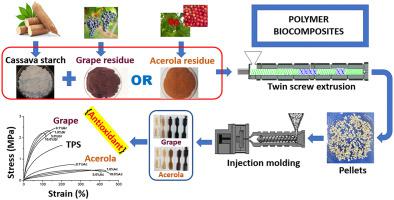当前位置:
X-MOL 学术
›
Polym. Test.
›
论文详情
Our official English website, www.x-mol.net, welcomes your feedback! (Note: you will need to create a separate account there.)
Influence of Grape and Acerola Residues on the Antioxidant, Physicochemical and Mechanical Properties of Cassava Starch Biocomposites
Polymer Testing ( IF 5.1 ) Pub Date : 2021-01-01 , DOI: 10.1016/j.polymertesting.2020.107015 Juciklécia S. Reinaldo , Carlos H.R. Milfont , Felipe P.C. Gomes , Adriano L.A. Mattos , Fábio G.M. Medeiros , Paula F.N. Lopes , Men de sá M. Souza Filho , Kátia N. Matsui , Edson N. Ito
Polymer Testing ( IF 5.1 ) Pub Date : 2021-01-01 , DOI: 10.1016/j.polymertesting.2020.107015 Juciklécia S. Reinaldo , Carlos H.R. Milfont , Felipe P.C. Gomes , Adriano L.A. Mattos , Fábio G.M. Medeiros , Paula F.N. Lopes , Men de sá M. Souza Filho , Kátia N. Matsui , Edson N. Ito

|
ABSTRACT The aim of this work was to develop cassava starch biocomposites with varius concentrations of grape skin (Gr) and acerola (Ac) residues (0.1, 1.0, 5.0 and 10.0 wt.%) using extrusion and injection molding processes. Grape residue had the highest concentration of total monomeric anthocyanin (ANC) and Ac had the highest concentration of total phenolic content (TPC) and total sugars. The starch and fruit residues had thermal degradation onset temperatures above the processing temperature profile of polymer biocomposites. The results showed that the antioxidant, physicochemical, mechanical, and morphological properties of these biocomposites were influenced by the type and concentration of the fruit residues. The addition of grape skins and acerola residues to the cassava thermoplastic starch resulted in better antioxidant characteristics, indicating the potential of these formulations for the development of new bioactive packaging obtained by large-scale processes.
中文翻译:

葡萄和针叶樱桃渣对木薯淀粉生物复合材料抗氧化、理化和机械性能的影响
摘要这项工作的目的是使用挤出和注塑工艺开发具有不同浓度的葡萄皮 (Gr) 和针叶樱桃 (Ac) 残留物(0.1、1.0、5.0 和 10.0 wt.%)的木薯淀粉生物复合材料。葡萄残渣的总单体花青素 (ANC) 浓度最高,Ac 的总酚含量 (TPC) 和总糖浓度最高。淀粉和水果残留物的热降解起始温度高于聚合物生物复合材料的加工温度曲线。结果表明,这些生物复合材料的抗氧化、理化、力学和形态特性受水果残留物类型和浓度的影响。在木薯热塑性淀粉中加入葡萄皮和针叶樱桃残渣,可产生更好的抗氧化特性,
更新日期:2021-01-01
中文翻译:

葡萄和针叶樱桃渣对木薯淀粉生物复合材料抗氧化、理化和机械性能的影响
摘要这项工作的目的是使用挤出和注塑工艺开发具有不同浓度的葡萄皮 (Gr) 和针叶樱桃 (Ac) 残留物(0.1、1.0、5.0 和 10.0 wt.%)的木薯淀粉生物复合材料。葡萄残渣的总单体花青素 (ANC) 浓度最高,Ac 的总酚含量 (TPC) 和总糖浓度最高。淀粉和水果残留物的热降解起始温度高于聚合物生物复合材料的加工温度曲线。结果表明,这些生物复合材料的抗氧化、理化、力学和形态特性受水果残留物类型和浓度的影响。在木薯热塑性淀粉中加入葡萄皮和针叶樱桃残渣,可产生更好的抗氧化特性,



























 京公网安备 11010802027423号
京公网安备 11010802027423号